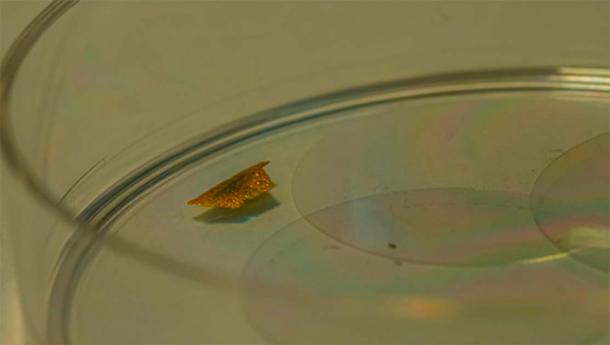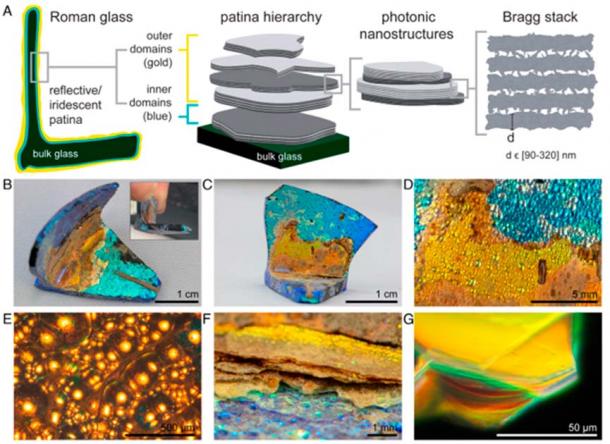
2,000-Year-Old Roman ‘Wow Glass’ Morphs Into Something Beautiful
Two millennia ago, delicate glass vessels that potentially served as containers for wine, water, exotic fragrances in ancient Rome, shattered and met their untimely demise. They found their way into the layers of the earth, going through the environmental changes that accompany erosion and corrosion, subject to humidity, temperature, mineral exposure, amongst others. In their present form, these shards of Roman glass are a range of gorgeous colors on the spectrum, from cerulean blues to notes of vibrant orange.
When Fiorenzo Omenetto, a materials scientist at Tufts University who co-authored the new paper, identified a shard during a visit at the Italian Institute of Technology's Center for Cultural Heritage Technology, he had a eureka moment! Terming it the “wow glass”, this particular fragment was uncovered near the ancient city of Aquileia, Italy. The shard was put under the scientific lens, and led to the publishing of a brilliant new study in the Proceedings of the Natural Academy of Sciences (PNAS).
Corrosion and Erosion: Nature the Ultimate Nanofabricator
Over the course of thousands of years, the molecules within the glass underwent a remarkable transformation, undergoing rearrangement and recombination with minerals. This intricate process led to the formation of what are scientifically known as photonic crystals—precisely ordered atomic arrangements that possess the unique ability to filter and reflect light in highly specific ways. These exquisite glass artifacts frequently find new life as components of jewelry, while their larger and more intact counterparts often grace the displays of esteemed museums.
- The Mysterious Connection Between Geophysics, Architecture and Biomedicine
- Heat, Blow, and Roll: The History of Glassblowing

A small sample of the ‘golden’ patina from a piece of Roman glass. (Florenzo Omenetto and Giulia Guidetti/PNAS)
Nature is often believed to be the ultimate nanofabricator. The applications of photonic crystals in modern technology can serve as the building blocks for creating waveguides, optical switches, and other cutting-edge devices that enable lightning-fast optical communications within computers and across the internet.
The “wow glass” prompted researchers to soon realize that what they were looking at was nanofabrication of photonic crystals by nature. “It’s really remarkable that you have glass that is sitting in the mud for two millennia and you end up with something that is a textbook example of a nanophotonic component,” said Omenetto.
By virtue of their engineered capacity to selectively block specific wavelengths of light while permitting others to pass through, photonic crystals play pivotal roles in the development of filters, lasers, mirrors, and even anti-reflection (stealth) devices.
The authors of this study have delved into the intricate atomic and mineral structures that emerged from the original silicate and mineral components of the glass. This process was modulated by factors such as the surrounding environment's pH levels and the fluctuating groundwater levels within the soil, reports a press release by Tufts University.
“This is likely a process of corrosion and reconstruction,” said Guidetti. “The surrounding clay and rain determined the diffusion of minerals and a cyclical corrosion of the silica in the glass. At the same time, the assembly of 100 nanometer-thick layers, combining the silica and minerals, also occurred in cycles.”
- Glass beads link King Tutankhamun and Bronze Age Nordic women
- Glass shard found at Japanese shrine matches artifacts from Persian Royal Palace

From the study depicts various views of aged Roman glass fragment and its iridescent patina. (Giulia Guidetti/Tufts University)
Conducting a Chemical Analysis of Roman Glass: Alternating Silicone Layers and Patina
The chemical analysis conducted by the Italian Institute of Technology team dated the glass fragment to a period spanning from 100 BC to 100 AD, with indications pointing to its origin in the sands of Egypt, suggesting global trade during that era. The majority of the fragment retained its original dark green hue, while a millimeter-thick patina on its surface exhibited an almost flawless mirror-like gold reflection, reports Ars Technica.
The result is an incredibly ordered arrangement of hundreds of layers of crystalline matter. Omenetto and Guidetti utilized a novel scanning electron microscope capable of not only unveiling the material's structure but also providing elemental analysis. Guidetti explained, "Basically, it’s an instrument that can tell you with high resolution what the material is made of and how the elements are put together."
Their examination revealed that the patina possessed a hierarchical structure consisting of regularly alternating silica layers, each micrometers-thick and varying in density, akin to reflectors known as ‘Bragg stacks’. Each Bragg stack displayed strong reflection of specific, relatively narrow wavelengths of light. The golden mirror-like appearance of the patina was the result of the vertical stacking of multiple Bragg stacks.
“While the age of the glass may be part of its charm, in this case if we could significantly accelerate the process in the laboratory, we might find a way to grow optic materials rather than manufacture them,” Omenetto explained.
The glass represents an opportunity to understand the environmental history of the ever changing ground, due to the city’s evolution. This will help with understanding the natural histories of many places that possess these shards embedded in the soil, going forward.
Top image: A magnified perspective of photonic crystals present on the surface of ancient Roman glass. Source: Giulia Guidetti/Tufts University
By Sahir Pandey
References
Guidetti, G. et al. 2023. Photonic crystals built by time in ancient Roman glass. Proceedings of the Natural Academy of Sciences, 120 (39). Available at: https://doi.org/10.1073/pnas.2311583120.
Ouelette, J. 2023. Ancient Roman “wow glass” has photonic crystal patina forged over centuries. Available at: https://arstechnica.com/science/2023/09/ancient-roman-wow-glass-has-photonic-crystal-patina-forged-over-centuries/.
Silver, M. 2023. Buried Ancient Roman Glass Formed Substance with Modern Applications. 2023. Available at: https://now.tufts.edu/2023/09/18/buried-ancient-roman-glass-formed-substance-modern-applications.















